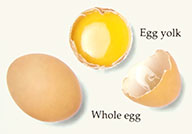Artists have painted for thousands of years, fixing pigments on walls with gum, glue, spit and raw egg. Wax was used as a medium on Egyptian wooden sarcophagi and, somewhat later than 800, wax was used in order to achieve greater veracity and immediacy in portraiture. Around 800, artists start to experiment with vegetable oils that harden in the air.
|
Egg tempera is bound with egg |
Oil paints are based in vegetable oils |
Here is a summary of the differences between egg tempera and oil paints:
| Tempera paints | Oil paints | |
|---|---|---|
| Ingredients | Pigment, egg and water | Pigment in vegetable oil |
| How it dries | Dries quickly, losing water | Dries slowly, reacting with oxygen. It also sets with little loss of ‘bulk,’ thus brushwork becomes more important |
| Availability | Immediate use only | Immediate use, or can be stored in bladders or tubes |
| Appearance | Matte finish (dried egg) | Brilliant finish (adding a coat of varnish) |


